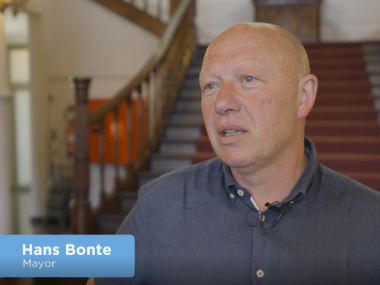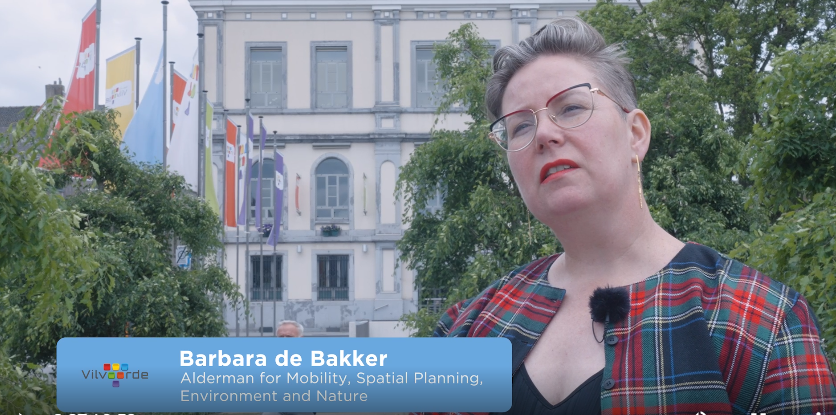City Reflections & Ambitions - Vilvoorde
Edited on
30 June 2022How can Vilvoorde develop into a pleasurable city by the water where it is good to live and work?
Vilvoorde's ambition is clear:
We already have our past, we can make our own future

Mayor Hans Bonte:
"Despite its heavily polluted historical industrial past, Vilvoorde has a number of unique assets such as its population and location. At the same time, as the fastest growing city in Flanders, Vilvoorde is facing enormous challenges: safety, mobility, quality of life, jobs, energy, diversity and social cohesion. The city has learned from the first climate plan that these are also the challenges that a bold climate policy can help to solve. Energy renovation improves the quality of life and creates jobs, and good cycle paths and neighbourhood renovation increase safety. Climate policy is therefore about much more than CO2 reduction alone. Although the challenges remain enormous, over the years we have noticed that Vilvoorde's climate policy is becoming increasingly integrated into all policy objectives"
Nevertheless, we need a sustainability revolution to respond to all the challenges we are facing.
Deputy Mayor Tine Paredis:
"The city has a great responsibility as an example to its inhabitants. With an ambitious and at the same time feasible climate policy 2025, Vilvoorde wants to continue working hard this legislative period with the available resources. One thing is certain: the city organisation cannot do this alone, as is evident from the long-term vision for 2030. The climate objective for 2030 exceeds the capacity of every individual, every company, city service and even the city as a whole. Collaboration therefore becomes the key to success. With every citizen, entrepreneur, government, volunteer, elected official and target group, we must work together"
Deputy Mayor Barbara De Bakker:
"An ambitious climate policy is also a story of enormous opportunities for the city. Besides CO2 reduction, adaptation or preparing the city for tomorrow is an opportunity to continue to grow into a healthy and green city by the water. With quality energy-efficient homes, more sustainable mobility and the strengthening of green and blue networks, we are striving for a city that is better for everyone"

Deputy Mayor Didier Cortois
"The participation of all our stakeholders will be crucial in this challenge. Not only our businesses and our associations, but every citizen of Vilvoorde will need to be involved in order to make his or her contribution. As a city, we are already taking the first steps here, but we also hope to learn a lot from other good examples through this Urbact project"
In the next years, the challenge for Vilvoorde is to translate this vision into realistic action plans as a guideline for future developments.
In the framework of the URBACT Zero Carbon Cities project, the city of Vilvoorde will adopt a local carbon budget to help guide strategic decisions on a policy level. Defining a carbon budget emphasizes the sense of urgency of climate action on a science-based method in alignment with targets set under the Paris Agreement. The global carbon budget framework defines the allowable cumulative emissions of carbon dioxide associated with a given level of global warming, since an emission of CO2 has the same effect on global temperature regardless of time of production.
Starting up a local stakeholder group is not easy for small cities because of a lack of time and capacity. To overcome this, several projects try to build up a stakeholder network through participatory processes. These are stakeholders who engage with the city on different fronts and in time can grow into a diverse mix of different perspectives.
In this way, we strive for long term sustainable cooperation that can lead to concrete results and actions.
By working with subgroups on different themes and projects, we get an ever-growing cooperation between the different city departments and local, regional and national stakeholders. With this approach, we avoid the think tank method and move much faster to concrete problems and hands on solutions and responsibilities.
The City of Vilvoorde 2030 climate plan shows ambition by focusing on the right goals. Both for its own organisation and city-wide. The SECAP 2030 kicks off in 3 ways:
• The 2025 climate policy with 4 budgeted concrete action plans for the coming legislature.
• With the climate in mind, all policy areas are looking for projects and investments which not only do what is necessary, but also make our city more sustainable and climate proof.
• Together with companies, residents and associations, we are looking for a long-term leverage effect, both locally and with the help of European initiatives.
The SECAP clearly indicates the long-term objectives, but also the challenges and the need for cooperation and participation. It was a starting document for targeted and science- based work.
The Urbact Zero Carbon Cities project has accelerated some of these objectives.
We know from the calculation of our carbon budget that the sense of urgency is very high if we are to move towards a sustainable and livable city, but we also know that we cannot possibly do this alone, and that we need to maximise cooperation with our local stakeholders.
We notice that it is not easy with the limited capacity and financial resources the city has to involve all stakeholders but some initiatives that can be leveraged are already in place.
The integrated action plan will hopefully continue to grow in the coming years so that together with all stakeholders we continue to build on an innovative city in transition and that we are ready for the changes and challenges that lie ahead.
Adequate funding and support from higher governments will be crucial to be able to to realize these ambitions. We stand up for a livable, sustainable and healthy city.
With this slogan:
The climate is changing, and so is Vilvoorde!
Submitted by Laura McIntosh on
